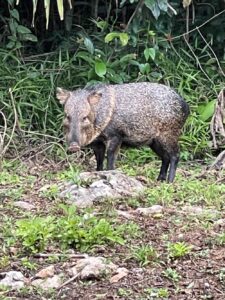Devon Swinburne is a Program Director who has led student programs in Patagonia, Argentina, Australia, Fiji, and New Zealand. She recently returned from Belize, where she reconnected with our local partners and put the finishing touches together for this summer’s Smithsonian program there. In this post, she reflects on her experiences on the ground.
Welcome to Belize! Located on the northeastern coast of Central America, Belize is a beautiful and diverse nation that is multicultural and multifaceted, where English, Spanish, Maya, Garifuna, and Creole are spoken. The Caribbean coast has 52 cayes (more on that below), small inland towns, dense riparian forest, Mennonite farmland, and jungles. In fact, Belize has the largest intact rainforest north of the Amazon! Many incredible jungle animals can be found at the wonderful place my adventure began: the Belize Zoo.
The Belize Zoo is an animal rehabilitation center and sanctuary that is home to over 200 native animals. Sharon Matola, who founded the zoo in 1983, strongly believed in rehabilitating native animals that were taken in by the government or injured, rather than bringing exotic animals to the zoo. This sanctuary provides a home to wounded or abandoned animals, and the caring staff brings the animals and people of Belize closer together by increasing awareness of and appreciation for Belize’s wildlife, and promoting the protection of the country’s natural resources.
After leaving our friends at the zoo, I headed into the jungle. In the heart of the Chiquibul Forest is Las Cuevas Research Station. Las Cuevas was started and built by the British Royal Engineers and is managed and operated by the Friends for Conservation and Development. A few park rangers and researchers live here year round and maintain the trails, projects, and buildings. There are specialized wildlife and ecological projects happening year round, including the endangered scarlet macaw breeding program.
In a matter of a few days I heard and saw more tropical ecology and wildlife than I previously thought possible. Did I mention it has ancient Maya temples on the property? And a giant cave holding sacred burial platforms and pottery from the Maya dating back to 700 BC! And nesting scarlet macaws (which we saw) and jaguars (just footprints)! During my time at this research station, it became clear how incredible the opportunity is for our students to dive into hands-on experiences, have wildlife sightings, local flora and fauna studies, and much more. What a treat!
From the jungle I then traveled to the edge of Belize’s mainland to begin my next adventure—on the water! Students on our Belize program come to Tobacco Caye Marine Station to lend a hand in reef clean ups, venture out for both daytime and night snorkels, and travel to other cayes to learn about nurdles, lionfish, and other invasive species. They study alongside the resident marine biologists to understand all things conservation and preservation on Belize’s rich coral reef!
This marine station is located on Tobacco Caye, one of Belize’s tiniest islands, which is only 200 feet wide and 400 feet long. Cayes are low-elevation land masses formed atop coral reefs. Loose sediment carried by the ocean accumulates and builds up on the reef, gradually creating the caye. During the day we snorkeled in bright turquoise waters while observing coral reef and local marine life, including two giant eagle rays that circling the island. By night we shone flashlights from the docks and watched tropical Caribbean octopus hunt for their dinner. A marine life paradise.

Through these experiences at the Belize Zoo and Tobacco Caye, working with conservationists, and studying marine life alongside scientists, our students this summer will be immersed in Belize’s conservation efforts that have become a model for the rest of the world. Smithsonian Student Travel students will see first hand what is happening to our earth—both above the waters and below.
Click here to learn more about our conservation and Maya history program in Belize.














